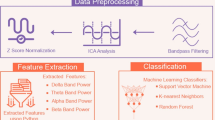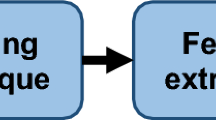Abstract
This paper presents a feature extraction approach for surveillance system aimed at achieving the automatic detection and recognition of public security events. The proposed approach first generates a Gabor dictionary based on the human auditory critical frequency bands, and then uses the orthogonal matching pursuit (OMP) algorithm to sparse abnormal audio signal. We select the optimal several important atoms from the Gabor dictionary and extract the scale, frequency, and translation parameters of the atoms to form the OMP feature. The performance of OMP feature is compared with traditional acoustic features and their joint features, using support vector machine (SVM) and random forest (RF) classifiers. Experiments have been performed to evaluate the effectiveness of the OMP feature for supplementing traditional acoustic features. The results show the superior performance classifier for abnormal acoustic event detection (AAED) is RF. Furthermore, the introduction of the combined features addresses the problems of low recognition accuracy and poor robustness for the surveillance system in practical applications.






Similar content being viewed by others
References
Shi, B., Sun, M., Kao, C. C., et al. (2019). Semi-supervised acoustic event detection based on tri-training. In Electrical engineering and systems science audio an speech processing (eess.AS), 29 April.
Passler, S., & Fischer, W. J. (2014). Food intake monitoring: Automated chew event detection in chewing sounds. IEEE Journal of Biomedical and Health Informatics, 18(1), 278–289.
Wang, J. C., Lin, C. H., Chen, B. W., et al. (2014). Gabor-based nonuniform scale-frequency map for environmental sound classification in home automation. IEEE Transactions on Automation Science & Engineering, 11(2), 607–613.
Sehili, M. E. A., Lecouteux, B., Vacher, M., et al. (2012). Sound environment analysis in smart home. Lecture Notes in Computer Science, 7683(7683), 208–223.
Lopatka, K., Kotus, J., & Czyzewski, A. (2016). Detection, classification and localization of acoustic events in the presence of background noise for acoustic surveillance of hazardous situations. Multimedia Tools and Applications, 75(17), 10407–10439.
Astapov, S., Berdnikova, J., Ehala, J., et al. (2018). Gunshot acoustic event identification and shooter localization in a WSN of asynchronous multichannel acoustic ground sensors. Multidimensional Systems and Signal Processing, 29, 563–595.
Dufaux, A., Besacier, L., Ansorge, M., et al. (2000) Automatic sound detection and recognition for noisy environment. In Proceedings of 2000 10th European signal processing conference (pp. 1–4), Tampere, September 2000.
Khunarsa, P., Lursinsap, C., & Raicharoen, T. (2010). Impulsive environment sound detection by neural classification of spectrogram and mel-frequency coefficient images. Advances in Neural Network Research and Applications, 67, 337–346.
Okuyucu, Ç., Sert, M., & Yazici, A. (2013) Audio feature and classifier analysis for efficient recognition of environmental sounds. In Proceedings 2013 IEEE international symposium on multimedia, Anaheim, CA, December 2013
Xia, X., Togneri, R., Sohel, F., et al. (2018). Random forest classification based acoustic event detection utilizing contextual-information and bottleneck features. Pattern Recognition, 81, 1–13.
Cohen R , Lavner Y . (2012). Infant cry analysis and detection. In Proceedings of 27th conference on electrical and electronics engineers (pp. 1–5), Eilat, Israel, November 2012.
Nguyen, Q., & Choi, J. S. (2017). Matching pursuit based robust acoustic event classification for surveillance systems. Computers and Electrical Engineering, 57, 43–54.
Wolpert, D. (1996). The lack of a priori distinctions between learning algorithms. Neural Computation, 8(7), 1341–1390.
Fernandez-Delgado, M., Cernadas, E., Barro, S., et al. (2014). Do we need hundreds of classifiers to solve real world classification problems. Journal of Machine Learning Research, 15, 3133–3181.
Hrabina, M., & Sigmund, M. (2017). Comparison of feature performance in gunshot detection depending on noise degradation. In Proceedings 27th international conference on RADIOELEKTRONIKA (pp. 1–4), Brno, Czech Republic, April 2017.
Chu, S., Narayanan, S., & Kuo, C. C. J. (2009). Environmental sound recognition with time-frequency audio features. IEEE Transactions on Audio, Speech and Language Processing, 17(6), 1142–1158.
Mallat, S. G., & Zhang, Z. (1993). Matching pursuits with time-frequency dictionaries. IEEE Transactions on Signal Processing, 41(12), 3397–3415.
Li, D., Tam, J., & Toub, D. (2013). Auditory scene classification using machine learning techniques. In Proceedings of the IEEE AASP challenge on detection and classification of acoustic scenes and events, New Paltz, NY, October 2013.
Petrovsky, A., Azarov, E., & Petrovsky, A. (2011). Hybrid signal decomposition based on instantaneous harmonic parameters and perceptually motivated wavelet packets for scalable audio coding. Signal Processing, 91(6), 1489–1504.
Sugden, P., & Canagarajah, N. (2003). Underdetermined noisy blind separation using dual matching pursuits. Electronics Letters, 39(1), 158–160.
Wei, P. I. (2010). Generalized demodulation method based on multi-scale chirplet and sparse signal decomposition and its application to gear fault diagnosis. Journal of Mechanical Engineering, 46(15), 63–68.
Schroder, J., Goetze, S., & Anemuller, J. (2015). Spectro-temporal gabor filterbank features for acoustic event detection. IEEE/ACM Transactions on Audio Speech and Language Processing, 23(12), 2198–2208.
Soussen, C., Rémi, G., Jérôme, I., et al. (2013). Joint K-step analysis of orthogonal matching pursuit and orthogonal least squares. IEEE Transactions on Information Theory, 59(5), 3158–3174.
Pace, M. A., Nicolás, U., Masson, F., et al. (2017). Critical frequencies for the annoyance judgments of noises with tonal component, to develop an equal-annoyance contour. Acoustical Society of America Journal, 141(5), 3883.
Zwicker, E. (1961). Subdivision of the audible frequency range into critical bands (Frequenzgruppen). The Journal of the Acoustical Society of America, 33(2), 248.
Breiman, L. (2001). Random forests. Machine Learning, 45(1), 5–32.
Phan, H., Marco, M., Mazur, R., et al. (2015). Random regression forests for acoustic event detection and classification. IEEE/ACM Transactions on Audio Speech and Language Processing, 23(1), 20–31.
Acknowledgements
This work was partially supported by the NSFC Grants 51675425, Natural Science Basic Research Plan in Shaanxi Province of China Grant Nos. 2018SF-365 and 2020ZDLGY06-09, the Dongguan Social Science and Technology Development (key) Project 20185071021600.
Author information
Authors and Affiliations
Corresponding author
Additional information
Publisher's Note
Springer Nature remains neutral with regard to jurisdictional claims in published maps and institutional affiliations.
Rights and permissions
About this article
Cite this article
Zhang, P., Wei, J., Liu, Z. et al. Abnormal Acoustic Event Detection Based on Orthogonal Matching Pursuit in Security Surveillance System. Wireless Pers Commun 114, 1009–1024 (2020). https://doi.org/10.1007/s11277-020-07405-z
Published:
Issue Date:
DOI: https://doi.org/10.1007/s11277-020-07405-z




